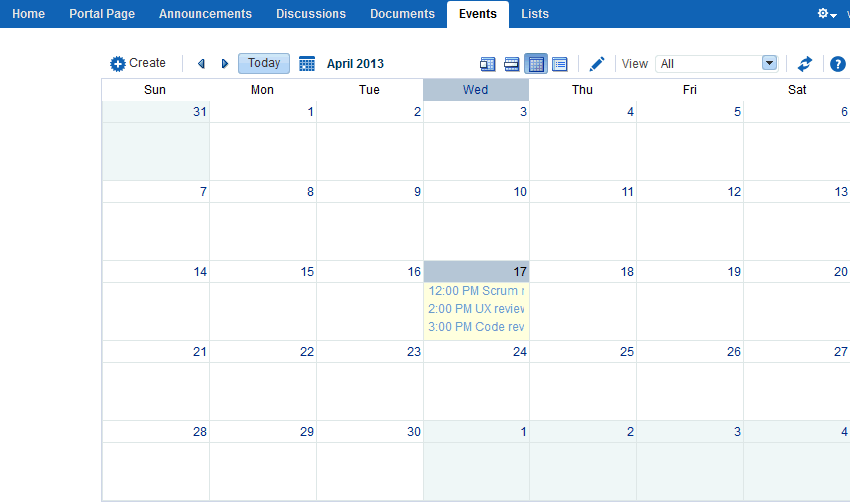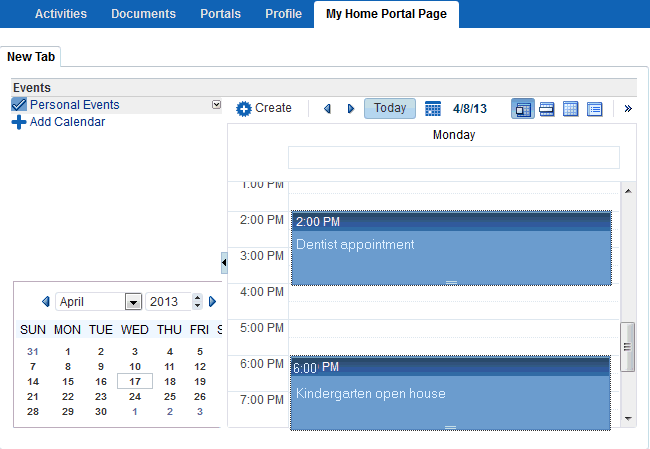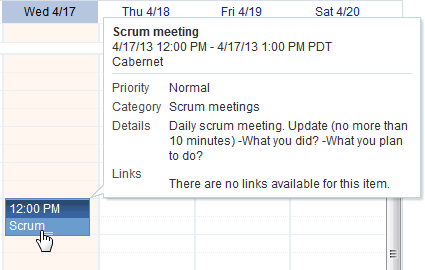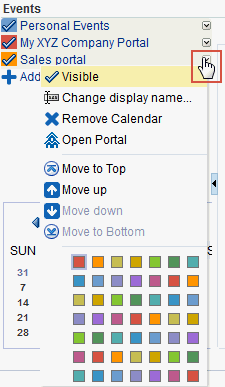29 Working with Calendars and Events
This chapter describes the features offered through events. Events provides calendars that you can use to schedule meetings, appointments, and any other types of occasions. Events also let you to view your own personal Microsoft Exchange calendar within the Home portal. Overlaying portal calendars on top of the Home portal calendar, allows you to view your entire schedule in a single place.
This chapter includes the following topics:
Permissions:
This chapter is intended for WebCenter Portal users who want to use the calendar and events feature to schedule and track events. The permissions to do the tasks in this chapter are granted by default to the portalParticipant role. However, you might not be able to do some tasks if one or more of the following advanced permissions for events have been set:
-
Create, Edit, and Delete Events -
View Events
Note:
Tasks discussed in this chapter are not available if events are not enabled and exposed. The portal moderator adds and configures events, as described in the "Adding a Calendar and Events to a Portal" section in Building Portals with Oracle WebCenter Portal.29.1 About Events
Events include appointments, meetings, presentations, and so on. Within WebCenter Portal, there are two kinds of events:
-
Personal events are those that are not related to a specific portal. They could include personal appointments with a doctor or dentist, or lunch with a friend.
Personal events come from your Microsoft Exchange calendar and display only to you in the Events viewer on a page in the Home portal. See Section 29.1.2, "Where to View Events" for viewing events in your personal calendar.
-
Portal events are those that are related to a specific portal. They could include weekly meetings, presentations, or a customer visit.
Portal events display to all members of the portal on the portal's dedicated Events page (or console) or in any Events viewer that is located on a page in the portal. Members with the required level of permission can schedule or update events.
Note:
If your application uses WebCenter Portal's default user roles, then the required permissions to create an event are included in both the participant and moderator roles. Participants and Moderators can manage all events.
29.1.1 Calendar Overlaying
In addition to viewing your personal events in your Home portal, you can also view portal events from selected portals all together in one place. This is referred to as calendar overlaying. In this way, you can have all your important events available in one location, your Home portal, rather than having to go to multiple portals to manage your daily schedule.
In a portal, if an Events page (or console) has been added, you can also add events to it. However, you can view personal events only in your Home portal.
See Section 29.1.2, "Where to View Events" for more information about viewing events with or without calendar overlaying.
Note:
Calendar overlaying must be enabled by your application specialist or portal moderator and set to a value other thanNone, if you want to view your personal events from your Microsoft Exchange calendar. See the "Enabling Calendar Overlaying" section in Building Portals with Oracle WebCenter Portal for more information.29.1.2 Where to View Events
Your portal may provide a variety of locations from which to view events.
See Also:
Section 29.2.2, "Viewing Events" and Section 29.2.6, "Displaying Multiple Calendars Together".-
Every portal in which events is enabled or included in the portal template includes an Events page (or console) that can be displayed or hidden. If you cannot see the Events page, it could be hidden. The application specialist or portal moderator has to provide a link to the Events viewer or expose the Events page from where you can access events. Figure 29-1 shows portal events on the Events page or console.
-
If your portal moderator has added the Events viewer to a page in a portal, you can view it from the portal navigation. Figure 29-2 shows events on another page in the portal.
Note:
You can only view personal events in the Home portal. -
Your portal moderator can also add events to a page in the Home portal, make that page visible, and give participants access to that page. In the Home portal, the Events viewer does not initially display the calendar of events from your personal calendar. You need to click Login to Personal Calendar. Figure 29-3 shows the events view on a page in the Home portal without calendar overlaying.
Figure 29-3 Events Viewer in Home Portal Before Logging In (Without Calendar Overlaying)

Description of ''Figure 29-3 Events Viewer in Home Portal Before Logging In (Without Calendar Overlaying)''
See Also:
For information about logging in to your Microsoft Exchange calendar, see Section 29.2.1, "Accessing Your Personal Events."If you do not have a Microsoft Exchange calendar, or do not want to display personal events, but still want to view portal events in the Home portal, ask your portal moderator to enable calendar overlaying. You can still see your portal events, as shown in Figure 29-4.
Figure 29-4 shows events in the Home portal with calendar overlaying.
Figure 29-4 Events Viewer in Home Portal Before Logging In (With Calendar Overlaying)

Description of ''Figure 29-4 Events Viewer in Home Portal Before Logging In (With Calendar Overlaying)''
If calendar overlaying is enabled, then click Personal Events (Figure 29-4) to see Login to Personal Calendar and then click Continue (Figure 29-5).
Figure 29-5 Events in Home Portal with Calendar Overlay Enabled

Description of ''Figure 29-5 Events in Home Portal with Calendar Overlay Enabled''
Note:
Calendar overlaying must be enabled by your portal moderator and set to a value other thanNone, if you want to view your personal events from your Microsoft Exchange calendar. See the "Enabling Calendar Overlaying" section in Building Portals with Oracle WebCenter Portal for more information.
29.1.3 Integration with Other Features
Through its tight integration with links, the events feature provides the opportunity to associate events with other WebCenter Portal assets. Linking enables you to associate documents, notes, announcements, discussions, and URLs with an event. You can create links from an event by editing the event and clicking the Links icon. For more information, see Section 32.2, "Working with Links Features."
Events also enables you to send mail messages about portal events to members of the portal. You can send mail from an event by editing the event and clicking the Send Mail icon. See Section 13.1, "About the Send Mail Feature" for information about working with the Mail feature.
29.2 Working with Events
Events include appointments, meetings, presentations, and so on. WebCenter Portal provides two kinds of event views for displaying personal and portal events:
-
The Events view provides a fully featured calendar where as well as viewing events in a variety of layouts, you can also create and manage events and display events from multiple calendars.
-
The Events - Mini View provides a more compact view of events as a list. You can view upcoming events and edit existing events. You cannot create new events in this view. This is useful if you want to provide information about events, but do not have enough space on the page for a full calendar.
Note:
The steps in the following sections apply to both personal events and portal events. Where there are any differences, these are noted.This section includes the following topics:
29.2.1 Accessing Your Personal Events
You can maintain a calendar of personal events outside of WebCenter Portal that does not relate to specific portals. If you use Microsoft Exchange 2003 or 2007 for this calendar, you can include your personal events in the Home portal. This keeps all your calendar information in a single place, making it much easier for you to organize your day.
You can view personal events in the Home portal. You can also edit or delete personal events or create new personal events that are pushed to your Exchange calendar.
Note:
Your portal moderator can set up a page to view events in the Home portal, from where you can view your personal events. See the "Showing Events on a Page in the Home Portal" section in Building Portals with Oracle WebCenter Portal.When setting up the Events view, your portal moderator can also enable calendar overlaying to display portal events alongside personal events in the Home portal. You can view your personal calendar events alongside portal events, but you cannot push portal events into your Exchange calendar. See Section 29.1.1, "Calendar Overlaying" for more information about calendar overlaying,
To access your personal events:
-
Navigate to the Home portal of the portal, and then to the page which contains your personal events (see Figure 29-3).
-
Click Login to Personal Calendar (Figure 29-6.
In the Home portal, the Events view does not initially display the calendar of events from your personal calendar. Instead it displays a link prompting you to Login to Personal Calendar (Figure 29-6).
Note:
If you see the link Try Again instead of Login to Personal Calendar, there is a problem with the connection to the Microsoft Exchange Server. Contact your system administrator.Figure 29-6 Events View in Home Portal Before Logging In (Without Calendar Overlaying)

Description of ''Figure 29-6 Events View in Home Portal Before Logging In (Without Calendar Overlaying)''
If you do not have a Microsoft Exchange calendar, or do not want to display personal events, but still want to view portal events in the Home portal, your portal moderator can enable calendar overlaying (see Section 29.1.1, "Calendar Overlaying"). Click Personal Events (Figure 29-7) and then click Continue (Figure 29-8).
Figure 29-7 Personal Events Link on a Page in the Home Portal
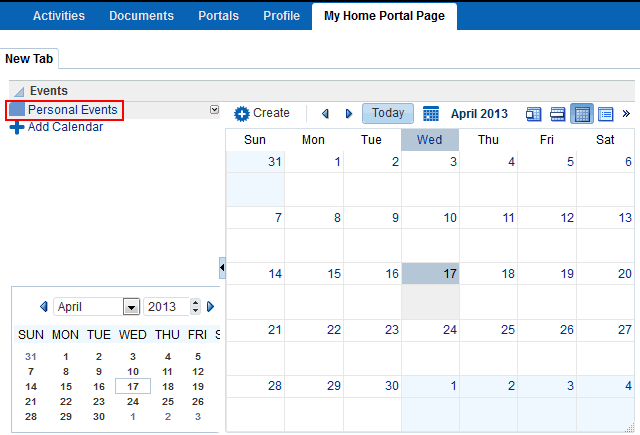
Description of ''Figure 29-7 Personal Events Link on a Page in the Home Portal''
Figure 29-8 Events View on a Page in the Home Portal (With Calendar Overlay Enabled)

Description of ''Figure 29-8 Events View on a Page in the Home Portal (With Calendar Overlay Enabled)''
-
In the External Application Login dialog that appears, enter your Microsoft Exchange login credentials and click OK.
Note:
The External Application Login dialog may include additional fields and information, depending on the requirements of the mail service that provides it. For more information about external applications and storing your login credentials in WebCenter Portal, see Section 5.7, "Providing Login Information for External Applications."Your personal calendar is displayed (Figure 29-9).
29.2.2 Viewing Events
You can view events as a grid or a list; choose to display events by day, week, or a month; filter events by category; select the range of hours displayed per day; and include a second time zone in the display.
See Also:
Section 29.1.2, "Where to View Events" for information on viewing the events on the Events page, on a page in the portal, and on a page in the Home portal.This section includes the following subsections:
29.2.2.1 Using the Calendar Interface
You can use icons to display events in grid form or as a list. When you display events as a grid, you can show them by day, week, or month. When you display events as a list, the number of upcoming events listed depends on the display options selected.
See Also:
See Section 29.2.2.4, "Setting Display Preferences" for information about changing List view display options.Usually, in grid mode, events are displayed for the current day, week, or month. To view events for a specific point in time, you can use the previous or next icons or select a date so that the calendar displays events for a specific date.
Table 29-1 lists the different icons available and describes their function.
Note:
The following options are not available in the Events - Mini View.| Icon | Description |
|---|---|
|
Click to display events from the previous day, week, or month. |
|
|
Click to display events from the next day, week, month. |
|
|
Click to display events for the current date (today). |
|
|
Click to display events for a specific date. Note: If the calendar overlay feature is enabled in Full mode then the Date Picker is always visible to the left of the calendar. |
|
|
Click to display events one day at a time. |
|
|
Click to display events for the whole week. |
|
|
Click to display events for the whole month. |
|
|
Click to display a list of upcoming events. The number of events listed depends on the settings (for more information, see Section 29.2.2.4, "Setting Display Preferences"). |
|
|
Click to display the Event Preferences dialog to specify calendar times, secondary time zones, and configure the list view (for more information, see Section 29.2.2.4, "Setting Display Preferences"). |
|
|
|
Select one or more event categories by which to filter the events in the calendar. Only events belonging to the selected categories are displayed in the calendar (for more information, see Section 29.2.2.3, "Filtering Events by Category"). |
|
Click to refresh the page with any recent changes. |
29.2.2.2 Viewing Event Details
The Events page (or console) or Events view displays basic information about events. To view more information, such as the location, start and end times, priority, category, or links, simply hover your mouse over an event.
The resulting window (Figure 29-10), displays the following information:
-
The title of the event
-
Details of the date and time of the event, including the secondary time zone if one has been specified
-
The priority of the event
-
The category to which the event belongs
-
The location of the event, if specified
-
Any links associated with the event
To view any specific details of the event, you must edit the event. See Section 29.2.4, "Revising Scheduled Events" for more information.
29.2.2.3 Filtering Events by Category
You can filter the events displayed in the calendar to show only those that belong to one or more particular categories, for example Team Meeting, Customer Meeting, Vacation, and so on.
See Also:
Event categories are created by the portal moderator in the portal administration settings. After they are created, you can use them to assign categories to your events, which enables you to then filter events by category. If your portal moderator did not create categories, you will not be able to categorize events. See the "Creating and Managing Portal Event Categories" section in Building Portals with Oracle WebCenter Portal.To filter events by category:
-
Go to the Events view or Events page where you want to filter events.
Note:
You cannot filter events in the Events - Mini View. The View drop-down list is available only for portal events, not personal events. -
In the toolbar, from the View drop-down list (Figure 29-11), select one or more categories by which you want to filter the events displayed in the calendar.
Figure 29-11 View List for Filtering by Event Category
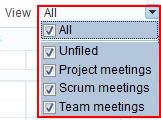
Description of ''Figure 29-11 View List for Filtering by Event Category''
When you close the drop-down list, only those events that belong to the selected category or categories are displayed in the calendar.
Tip:
To remove event filtering, deselect any of the categories in the View drop-down list.
29.2.2.4 Setting Display Preferences
Events display preferences allows you to do the following:
-
Determine the earliest time displayed on the calendar when events are viewed by day or week.
-
Identify a secondary time zone.
-
Specify how to display events in List view: by day, week, month, or for a specified number of days.
To set these preferences, click the Set Event Preferences icon (Figure 29-12) to access the Event Preferences dialog (Figure 29-13).
Note:
The Set Event Preferences icon, and therefore the Event Preferences dialog, is not available in the Events - Mini View viewer.This section includes the following topics:
29.2.2.4.1 Setting the Calendar Start Time
In Day and Week view, the calendar grid is divided into hours. If vertical space for your calendar is limited, you can specify the earliest hour to display on the calendar grid to save space. If the space available has enough room to display hours from before the specified start time until 11PM, it does so.
To set the calendar start time:
-
Go to the Events view or Events page where you want to set the calendar start time.
-
Click the Set Event Preferences icon on the toolbar (Figure 29-12).
-
In the Event Preferences dialog (Figure 29-13), from the Start Time drop-down list, select the earliest hour to display on the grid.
Choose from 12AM to 11PM.
-
Click OK to save your changes.
29.2.2.4.2 Setting a Secondary Time Zone
These days, it is not unusual to be working in teams with members in different locations. When scheduling meetings, it is useful to know the hours most optimal to all invitees. To make this easier, you can specify a secondary time zone to see what time a meeting is in that time zone as well as your own.
When you hover your mouse over an event, the event details window shows the time of the meeting in your time zone and in the secondary time zone (Figure 29-14).
Figure 29-14 Event Details Window Displaying Primary and Secondary Time Zones
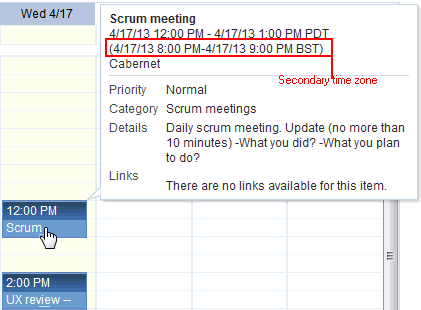
Description of ''Figure 29-14 Event Details Window Displaying Primary and Secondary Time Zones''
To set a secondary time zone:
-
Go to the Events view or Events page where you want to set a secondary time zone.
-
Click the Set Event Preferences icon on the toolbar (Figure 29-12).
-
In the Event Preferences dialog (Figure 29-15), from the Secondary Time Zone drop-down list, select a secondary time zone to display along with the primary time zone.
Figure 29-15 Event Preferences Dialog Showing Secondary Time Zones
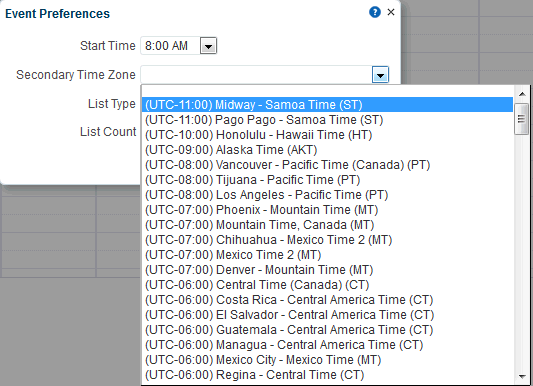
Description of ''Figure 29-15 Event Preferences Dialog Showing Secondary Time Zones''
-
Click OK to save your changes.
29.2.2.4.3 Configuring List View
You can specify how you want to display events, when the calendar is displayed in List view. You can display events by day, week, month, or for a specified number of days.
To configure List view:
-
Go to the Events view or Events page where you want to configure List view.
-
Click the Set Event Preferences icon on the toolbar (Figure 29-12).
-
In the Event Preferences dialog (Figure 29-16), from the List Type drop-down list, select how you want to display events in List view:
Figure 29-16 Event Preferences Dialog Showing List Types
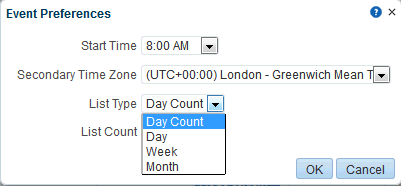
Description of ''Figure 29-16 Event Preferences Dialog Showing List Types''
-
Day Count—List all upcoming events for a specified number of days.
-
Day—List all upcoming events for the currently selected day.
-
Week—List all upcoming events for the currently selected week.
-
Month—List all upcoming events for the currently selected month.
-
-
If you selected Day Count in the previous step, in the List Count field, specify the number of days for which you want to display events. The default is 14.
-
Click OK to save your changes.
29.2.3 Scheduling Events
You can schedule portal events and personal events. When you schedule a personal event, the details are pushed to your Microsoft Exchange calendar.
Note:
You cannot schedule new events in the Events - Mini View.To schedule an event:
-
Go to the Events view or Events page where you want to schedule the event.
-
Click Create on the toolbar (Figure 29-17).
The Create Event dialog opens (see Figure 29-18 and Figure 29-19). The fields in the Create Event dialog are slightly different depending on whether you are creating a personal event or a portal event. These differences are pointed out later in this procedure.
Note:
You can also easily invoke the Create Event dialog in grid view by double-clicking an empty space or right-clicking an empty space and selecting Create. The advantage of this is that the date and time of the event are automatically specified in the dialog.Figure 29-18 shows the Create Event dialog invoked from the Events page.
Figure 29-18 Create Event Dialog Invoked From the Events Page
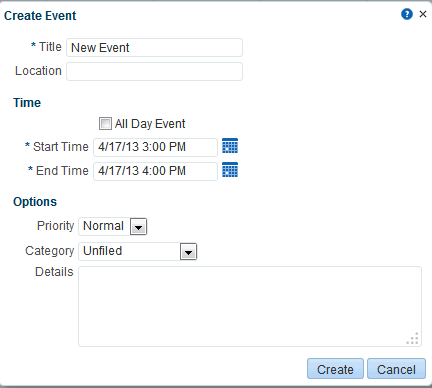
Description of ''Figure 29-18 Create Event Dialog Invoked From the Events Page''
Figure 29-19 shows the Create Event dialog invoked from the a page in the Home portal.
Figure 29-19 Create Event Dialog Invoked From a Home Portal Page

Description of ''Figure 29-19 Create Event Dialog Invoked From a Home Portal Page''
-
In the Title field, enter a brief descriptive title for the event.
For example,
Project Update. -
In the Location field, enter the location of the event.
For example,
Conference Room 5. -
From the Calendar drop-down list, select the calendar in which you want to create the event.
Note:
The Calendar drop-down list is available only when the calendar overlay feature is enabled and at least one other calendar is displayed.The Calendar drop-down list is not available for events created from the Events page (where calendar overlaying is not available).
See Section 29.1.1, "Calendar Overlaying" for more information.
-
Select All Day Event to block out the entire day for the event.
All day events can span multiple days. In Day and Week view mode, all day events are displayed in a separate area at the top of the calendar. In Month view, all day events are displayed surrounded by a block of color.
-
In the Start Time field enter a date and time to start the event.
Tip:
You can click the Select Date and Time icon and select a start time from the Date and Time Picker, if you prefer.For all day events, you specify the date only.
-
In the End Time field enter a date and time to finish the event.
Tip:
You can click the Select Date and Time icon and select an end time from the Date and Time Picker, if you prefer.For all day events, you specify the date only.
-
(Optional) From the Priority drop-down list, select a priority for the event: Highest, High, Normal, Low, or Lowest.
The priority of an event determines where it appears when events conflict. An event with Highest priority is displayed first. The event priority is also displayed in the event popup window when a user hovers the mouse over the event.
-
(Optional) If your portal moderator set up event categories, from the Category drop-down list, you can select a category to classify this event.
Categories are useful for creating distinct groups of events, organized according to their general purpose. See the "Creating and Managing Portal Event Categories" section in Building Portals with Oracle WebCenter Portal.
The event category is displayed in the event popup window when a user hovers the mouse over the event. Events in different categories can be displayed in different colors if the portal moderator used colors to specify categories.
You can also filter a calendar to display events belonging to a specific category.
Note:
The Category drop-down list is available only for portal events. -
(Optional) In the Details field, enter any additional details you want to include, up to a maximum of 4000 characters.
For example, you might want to describe the purpose of the meeting, provide a brief agenda, or indicate if attendees need to prepare anything for the meeting.
Note:
The details that you enter here are available only when editing the event; they do not display in the event popup window when users hover over the event. You should not assume that all users will read these details. Important details about the meeting should be communicated in a different way, for example, through the meeting notification email or by creating an announcement. -
(Optional) Select Private if you do not want other users to be able to view your personal events.
If events are included on a page in the Home portal that you have made available to other users, then those users are not able to see the event.
Note:
The Private check box is available only for personal events. -
Click Create to add the event to the calendar.
Figure 29-20 shows events in day view.
29.2.4 Revising Scheduled Events
You may want to change some aspect of an event; for example, it may become necessary to change the time to accommodate a particular attendee, or the location may become unavailable.
To revise a scheduled event:
-
Click the event to open the Edit Event dialog (Figure 29-21) or right-click and select Edit (Figure 29-22).
Tip:
In the Events view or Events page, you can also access the Edit Event dialog by right-clicking an event and selecting Edit, or by moving the mouse pointer (or using theTabkey) to highlight an event and pressingEnter.Figure 29-21 Edit Event Dialog Invoked from a Portal Page
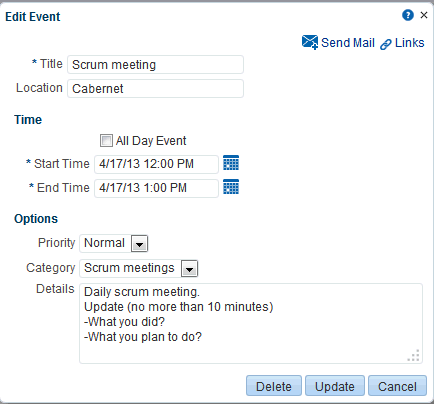
Description of ''Figure 29-21 Edit Event Dialog Invoked from a Portal Page''
-
Revise the event details.
See Also:
Section 29.2.3, "Scheduling Events" for information about the different options available in the dialog.Section 13.1, "About the Send Mail Feature" for information about using the Send Mail feature.
Section 32.2, "Working with Links Features" for information about creating links to other assets.
-
Click Update to save your changes.
29.2.5 Cancelling Scheduled Events
To cancel a scheduled event:
-
Right-click the event and select Delete (Figure 29-22).
Tip:
You can also delete an event by hovering your mouse over the event and pressing theDeletekey or, in the Edit Event dialog (see Section 29.2.4, "Revising Scheduled Events"), by clicking Delete.To delete an event from the Events - Mini View, you must open the Edit Event dialog and click Delete.
-
Click Delete in the Delete Confirmation dialog.
The event is removed from the calendar.
29.2.6 Displaying Multiple Calendars Together
Within WebCenter Portal, you can be a member of several portals. Each of those portals may have its own calendar of events. In addition to that, you may also have your own calendar where you track those events that concern only yourself. At the start of each day, it is not practical to have to view each of these calendars individually to determine your schedule for the day.
WebCenter Portal lets you view multiple calendars together. This is called calendar overlaying. You can do this in the Home portal so that you can also include your personal appointments from your personal calendar as well as view events from other portals. You can also overlay calendars in the Events view on a portal page.
Note:
Multiple calendars are available if calendar overlaying is enabled (see Section 29.1.1, "Calendar Overlaying"). Multiple calendars are not available on the Events page. Calendar overlaying must be enabled on the Home portal page and the page in your portal where you can view events.See also, Section 29.1.2, "Where to View Events."
The events from each calendar are displayed in a different color to help identify the source of the event. (Categories are available if your portal moderator set up categorization for events.) If calendars are overlaid on a page in the Home portal or on a portal page, category colors are used only for events from the current portal. All events from overlaid calendars are displayed in the color defined for that portal if the events do not have categories. But if the overlaid calendars have event categories, then the events with category will be shown for the calendars from other portals, provided the portal in which overlay is enabled has that same category.
This section includes the following topics:
29.2.6.1 Displaying Additional Calendars
When the calendar overlaying feature is enabled, users can display as many calendars as they want. Each calendar's events are displayed in a different color to make it easier to distinguish which calendar it belongs to.
To display additional calendars:
-
Go to the Home portal or the appropriate portal and locate the page that contains events.
-
In the calendar overlay area of events, click the Add Calendar icon (Figure 29-23).
-
In the Add Calendar dialog (Figure 29-24), select the portal whose calendar you want to display.
You can select multiple portals.
-
Click Add Calendar.
The calendar overlay area now includes the selected portals on the left.
-
Select the check box next to each portal whose calendar you want to view.
Note:
Events must be enabled and available in the portals you select.The events from each portal are displayed in a different color (Figure 29-25).
Figure 29-25 Events From Multiple Calendars

Description of ''Figure 29-25 Events From Multiple Calendars''
29.2.6.2 Editing Calendar Display Options
After adding a portal's events to your calendar you can change various display options, including the order the calendar appears in the list and the color used to identify events from the calendar.
To edit calendar display options:
-
Go to the Home portal or the appropriate portal and locate the page that contains events.
-
Click the arrow icon to the right of the portal for which you want to edit display options.
The calendar overlay menu is displayed (Figure 29-26).
-
From the menu, select:
-
Visible to toggle the display of this portal's events in the calendar.
You can also toggle the display of a portal's events by clicking the portal name (Full view only) or the colored square next to the portal name.
-
Change display name to make the name in the list of portals in Full view more meaningful to you than just the portal name.
-
Remove Calendar to remove this portal's calendar.
-
Open Portal to open the portal associated with this calendar.
-
Move to Top/Move up/Move down/Move to Bottom to rearrange this portal in the list.
The order in which the portals are listed determines the order in which events are listed when events from multiple portals occur in the same time slot. Events from the portal at the top of the list are displayed first.
-
A color to change the color used for the events from this portal.
-
29.2.7 Subscribing to Events
By default, if you subscribe to be notified when an event is created, updated, or deleted, the notification appears in your Activity Stream (if the view is available in your portal). However, you can subscribe to receive notifications by mail when events for a particular portal are created, updated, or deleted.
See Also:
See Section 22.3, "Subscribing to the Application, to Portals, and to Objects" for information about how to subscribe.When you subscribe to a portal's events, whenever an event is created, updated, or deleted in that portal, a notification is sent to you. If the client to which that notification is sent supports iMIP (for example, Microsoft Outlook, Mozilla Thunderbird, Gmail, and so on), the notification email includes the ability to accept or decline the event, propose a new time for the event, and so on within the email.
Figure 29-27 Email Notification for a Portal Event
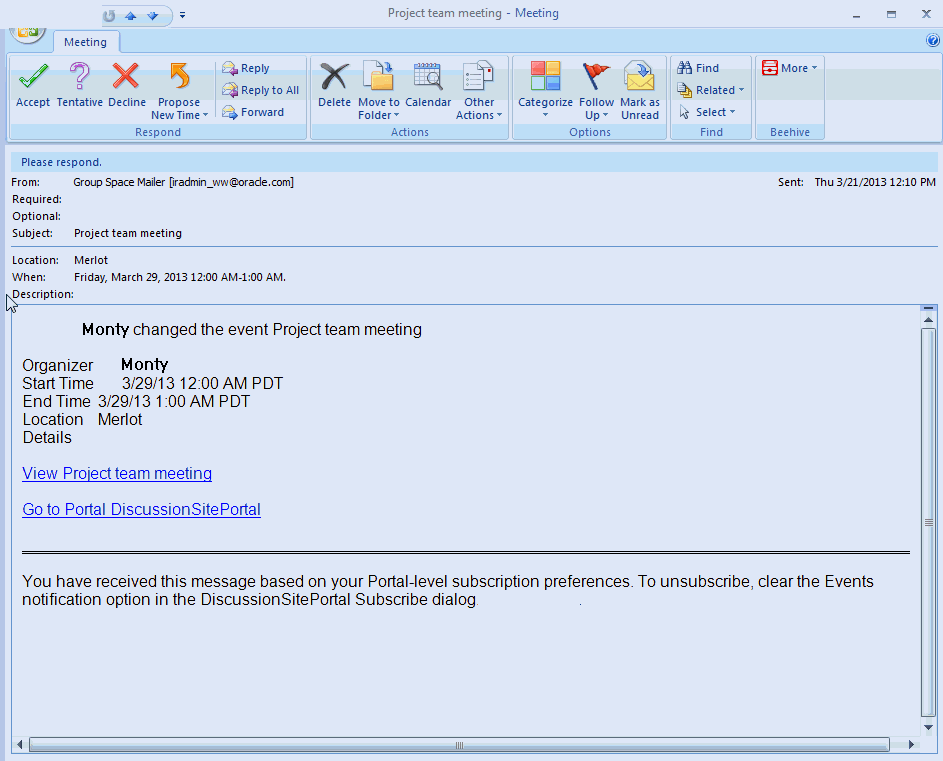
Description of ''Figure 29-27 Email Notification for a Portal Event''
If you accept an event, it is added to your calendar in your email client.
